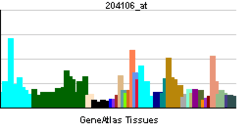TESK1
| Testis-specific kinase 1 | |||||||||||||
|---|---|---|---|---|---|---|---|---|---|---|---|---|---|
| Identifiers | |||||||||||||
| Symbol | TESK1 | ||||||||||||
| External IDs | OMIM: 601782 MGI: 1201675 HomoloGene: 4577 ChEMBL: 5604 GeneCards: TESK1 Gene | ||||||||||||
| EC number | 2.7.12.1 | ||||||||||||
| |||||||||||||
| RNA expression pattern | |||||||||||||
 | |||||||||||||
| More reference expression data | |||||||||||||
| Orthologs | |||||||||||||
| Species | Human | Mouse | |||||||||||
| Entrez | 7016 | 21754 | |||||||||||
| Ensembl | ENSG00000107140 | ENSMUSG00000028458 | |||||||||||
| UniProt | Q15569 | O70146 | |||||||||||
| RefSeq (mRNA) | NM_006285 | NM_011571 | |||||||||||
| RefSeq (protein) | NP_006276 | NP_035701 | |||||||||||
| Location (UCSC) |
Chr 9: 35.61 – 35.61 Mb |
Chr 4: 43.44 – 43.45 Mb | |||||||||||
| PubMed search | |||||||||||||
Dual specificity testis-specific protein kinase 1 is an enzyme that in humans is encoded by the TESK1 gene.[1][2]
Function
This gene product is a serine/threonine protein kinase that contains an N-terminal protein kinase domain and a C-terminal proline-rich domain. Its protein kinase domain is most closely related to those of the LIM motif-containing protein kinases (LIMKs). The encoded protein can phosphorylate myelin basic protein and histone in vitro. The testicular germ cell-specific expression and developmental pattern of expression of the mouse gene suggests that this gene plays an important role at and after the meiotic phase of spermatogenesis.[2]
Interactions
TESK1 has been shown to interact with YWHAB[3] and SPRY4.[4]
References
- ↑ Toshima J, Ohashi K, Okano I, Nunoue K, Kishioka M, Kuma K, Miyata T, Hirai M, Baba T, Mizuno K (February 1996). "Identification and characterization of a novel protein kinase, TESK1, specifically expressed in testicular germ cells". J. Biol. Chem. 270 (52): 31331–7. doi:10.1074/jbc.270.52.31331. PMID 8537404. Check date values in:
|year= / |date= mismatch(help) - 1 2 "Entrez Gene: TESK1 testis-specific kinase 1".
- ↑ Toshima JY, Toshima J, Watanabe T, Mizuno K (November 2001). "Binding of 14-3-3beta regulates the kinase activity and subcellular localization of testicular protein kinase 1". J. Biol. Chem. 276 (46): 43471–81. doi:10.1074/jbc.M104620200. PMID 11555644.
- ↑ Leeksma OC, Van Achterberg TA, Tsumura Y, Toshima J, Eldering E, Kroes WG, Mellink C, Spaargaren M, Mizuno K, Pannekoek H, de Vries CJ (May 2002). "Human sprouty 4, a new ras antagonist on 5q31, interacts with the dual specificity kinase TESK1". Eur. J. Biochem. 269 (10): 2546–56. doi:10.1046/j.1432-1033.2002.02921.x. PMID 12027893.
Further reading
- Toshima J, Tanaka T, Mizuno K (1999). "Dual specificity protein kinase activity of testis-specific protein kinase 1 and its regulation by autophosphorylation of serine-215 within the activation loop". J. Biol. Chem. 274 (17): 12171–6. doi:10.1074/jbc.274.17.12171. PMID 10207045.
- Røsok O, Pedeutour F, Ree AH, Aasheim HC (1999). "Identification and characterization of TESK2, a novel member of the LIMK/TESK family of protein kinases, predominantly expressed in testis". Genomics 61 (1): 44–54. doi:10.1006/geno.1999.5922. PMID 10512679.
- Toshima J, Toshima JY, Amano T, Yang N, Narumiya S, Mizuno K (2001). "Cofilin phosphorylation by protein kinase testicular protein kinase 1 and its role in integrin-mediated actin reorganization and focal adhesion formation". Mol. Biol. Cell 12 (4): 1131–45. doi:10.1091/mbc.12.4.1131. PMC 32292. PMID 11294912.
- Toshima J, Toshima JY, Takeuchi K, Mori R, Mizuno K (2001). "Cofilin phosphorylation and actin reorganization activities of testicular protein kinase 2 and its predominant expression in testicular Sertoli cells". J. Biol. Chem. 276 (33): 31449–58. doi:10.1074/jbc.M102988200. PMID 11418599.
- Toshima JY, Toshima J, Watanabe T, Mizuno K (2001). "Binding of 14-3-3beta regulates the kinase activity and subcellular localization of testicular protein kinase 1". J. Biol. Chem. 276 (46): 43471–81. doi:10.1074/jbc.M104620200. PMID 11555644.
- Leeksma OC, Van Achterberg TA, Tsumura Y, Toshima J, Eldering E, Kroes WG, Mellink C, Spaargaren M, Mizuno K, Pannekoek H, de Vries CJ (2002). "Human sprouty 4, a new ras antagonist on 5q31, interacts with the dual specificity kinase TESK1". Eur. J. Biochem. 269 (10): 2546–56. doi:10.1046/j.1432-1033.2002.02921.x. PMID 12027893.
- LaLonde DP, Brown MC, Bouverat BP, Turner CE (2005). "Actopaxin interacts with TESK1 to regulate cell spreading on fibronectin". J. Biol. Chem. 280 (22): 21680–8. doi:10.1074/jbc.M500752200. PMID 15817463.
- Rual JF, Venkatesan K, Hao T, Hirozane-Kishikawa T, Dricot A, Li N, Berriz GF, Gibbons FD, Dreze M, Ayivi-Guedehoussou N, Klitgord N, Simon C, Boxem M, Milstein S, Rosenberg J, Goldberg DS, Zhang LV, Wong SL, Franklin G, Li S, Albala JS, Lim J, Fraughton C, Llamosas E, Cevik S, Bex C, Lamesch P, Sikorski RS, Vandenhaute J, Zoghbi HY, Smolyar A, Bosak S, Sequerra R, Doucette-Stamm L, Cusick ME, Hill DE, Roth FP, Vidal M (2005). "Towards a proteome-scale map of the human protein-protein interaction network". Nature 437 (7062): 1173–8. doi:10.1038/nature04209. PMID 16189514.
This article is issued from Wikipedia - version of the Sunday, August 02, 2015. The text is available under the Creative Commons Attribution/Share Alike but additional terms may apply for the media files.